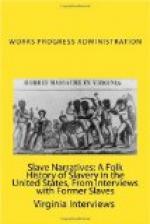Kentucky did not, as other southern states, secede from the Union, but attempted to be neutral during the Civil War. The people, however, were divided in their allegience, furnishing recruits for both the Federal and Confederate armies. The president of the Union, Abraham Lincoln, and the president of the Confederacy, Jefferson Davis, both were born in this state.
Boyd County was formed in 1860 from parts of Lawrence, Greenup and Carter Counties, and we are unable to find any records, in Boyd County, as to slave holders and their slaves, though it is known that many well to do families the Catletts, Davis, Poages, Williams and others were slave holders.
Slaves were not regarded as persons, had no civil rights and were owned just as any other chattel property, were bought and sold like horses and cattle, and knew no law but the will of their white masters and like other domestic animals could be, and were, acquired and disposed of without regard to family ties or other consideration.
Usually, as each slave represented a large investment of money, they were well cared for, being adequately fed, clothed and sheltered, having medical attention when sick.
As, along the border in Kentucky, there were no large plantations where field workers could be used, most of the slaves in this region were house servants, who were housed in wings of the master’s house, where the plantations were large enough to need many slaves, they were furnished one, or two, rooms cabins close by the mansion on the master’s estate.
As educated people are apt to be able to figure out ways to improve their lot, learning among the negroes was not encouraged, in fact it was illegal to teach them. In some instances an enlighted and humane master would teach a servant, and often they could find some one who would teach them secretly. As a race, however, they were, at the time they were set free, without any education at all.
Tales are told of cruel masters who overworked, flogged and otherwise mistreated their helpers and slaves; these masters, however, seem to have been an exception to the rule and considering that they were generally well provided for, many slaves were better off economically than the laborer of today who is a victim of misfortunes such as sickness, disability and old age.
One reason why slaves were better treated here than further south, was that Kentucky was a border state, and throughout Ohio and other northern states, was an organization known as the “Underground Railroad.” This was a sort of secret society whose members were sworn to assist escaped slaves to run away to Canada where they would be free. When a run-away slave crossed the Ohio River he would be met by some one of this organization and taken where he could remain in hiding by day, then by traveling by night, could reach another place of concealment by morning, where he would be fed and hidden until darkness permitted him to reach the next haven. By this means many were successful in reaching freedom, though they were hunted by officers, armed with guns, and assisted by fierce dogs especially trained for this work.




